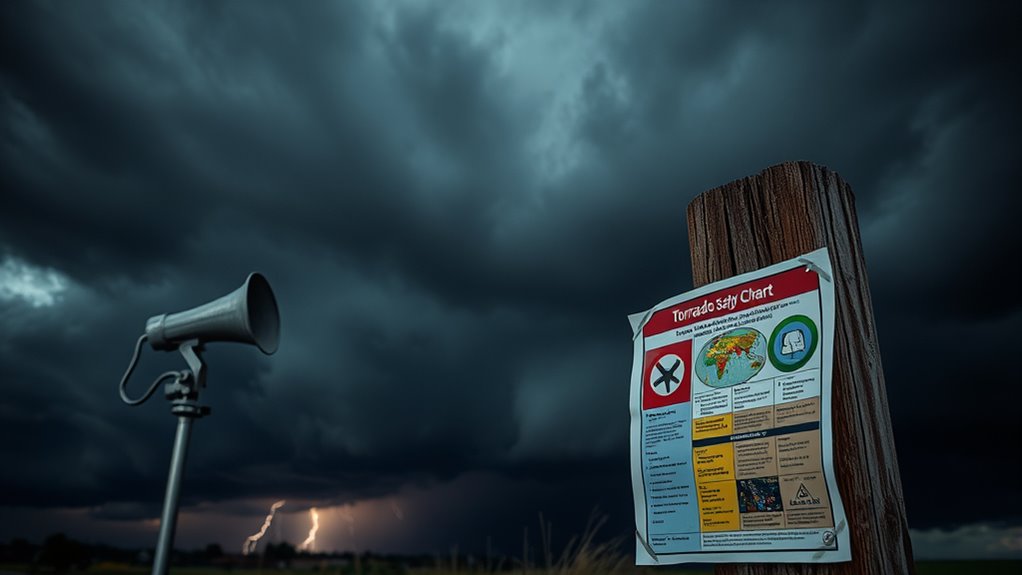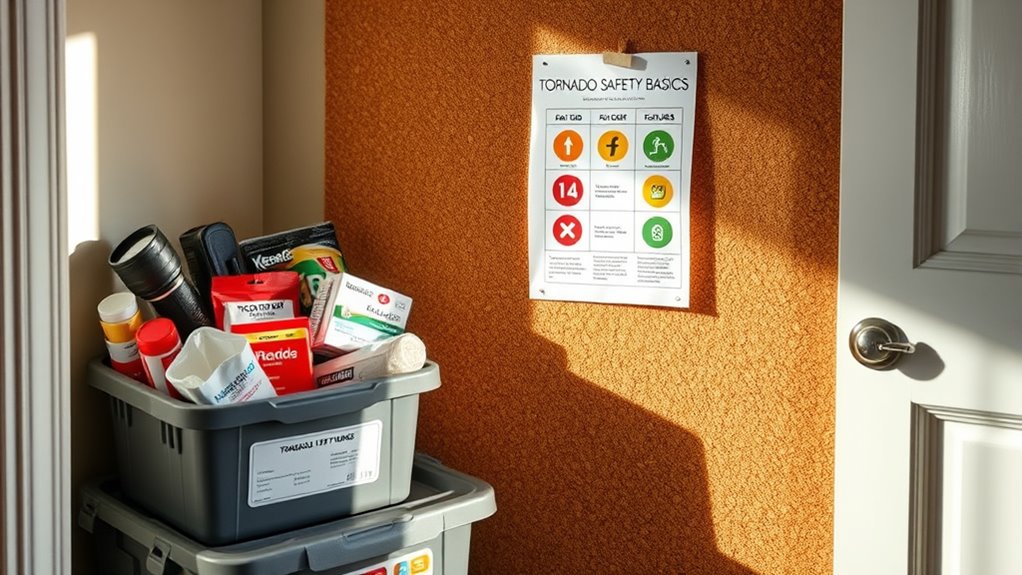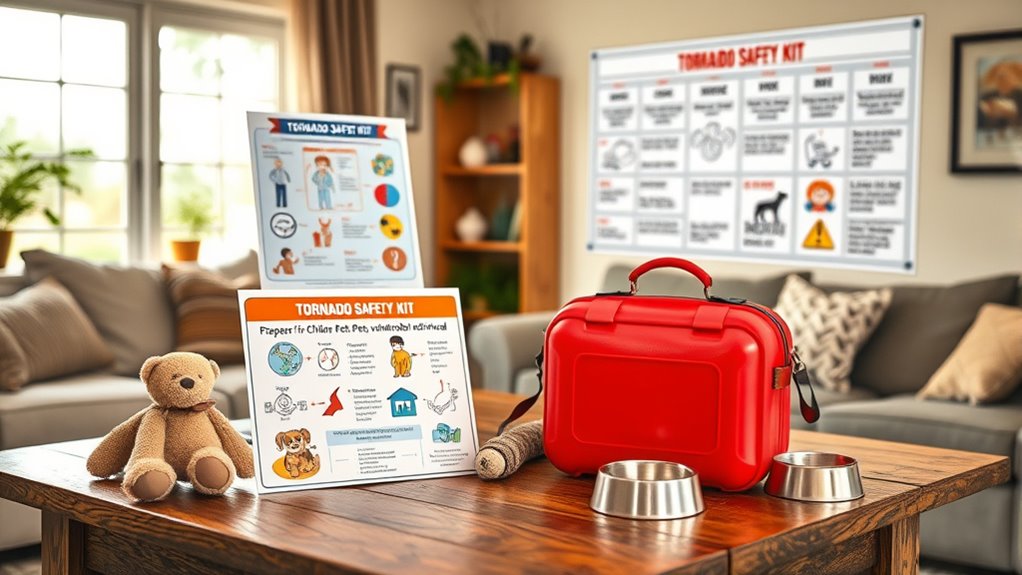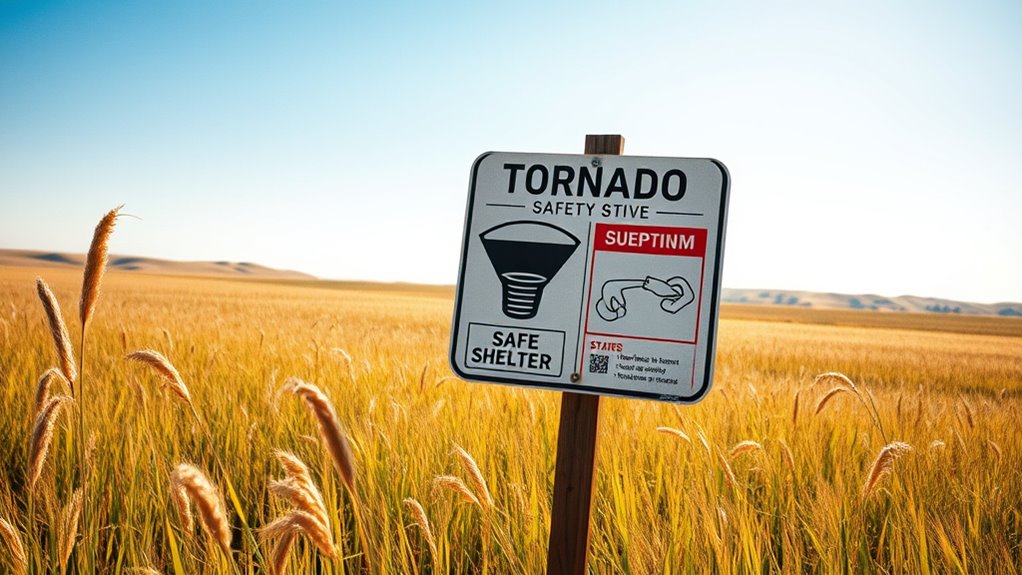To stay safe during a tornado, recognize warning signs like darkening skies, roaring sounds, and sensor alerts on your weather radio. Prepare an emergency kit with water, food, flashlight, and first aid supplies in a reinforced safe room. Act quickly by moving to this space and covering your head when a warning is issued. Protect children, pets, and vulnerable people, and after the storm, check for hazards and seek help. Keep learning to enhance your safety measures.
Key Takeaways
- Recognize early warning signs and use sensor alerts or weather radios for real-time updates.
- Prepare an accessible, stocked safe room with essentials like water, food, and a first aid kit.
- Move swiftly to the lowest, interior part of your home at the first sign of a tornado warning.
- Protect children, pets, and vulnerable individuals by guiding them to secure, interior spaces and offering reassurance.
- After a tornado, check for injuries, avoid hazards, document damage, and follow official safety instructions.
Recognizing Tornado Warnings and Alerts

Recognizing tornado warnings and alerts quickly can save your life. Modern sensor alerts are vital because they detect dangerous weather conditions early, giving you precious time to act. Pay attention to official warning signs, such as sky darkening, a roaring sound, or a sudden drop in temperature. Weather radios and smartphone alerts provide real-time updates, helping you stay informed. Many areas now use sensor alerts that send direct notifications when a tornado is nearby, so you don’t have to rely solely on visual cues. By familiarizing yourself with warning signs and trusting sensor alerts, you can respond swiftly and confidently. Enhancing color accuracy in your home setup can also help you better interpret visual weather cues, ensuring you notice signs quickly. Staying alert and aware of these signals ensures you’re prepared to seek shelter immediately when a tornado threatens your area.
Preparing Your Emergency Kit and Safe Room

Once you’ve tuned into tornado warnings and alerts, the next step is to prepare your emergency kit and safe room. Your storm shelter should be easily accessible and stocked with essential emergency supplies, including water, non-perishable food, a flashlight, batteries, a first aid kit, and necessary medications. Consider adding a battery-powered radio to stay updated if power goes out. Make sure your safe room is a small, windowless space like a closet or basement room, reinforced if possible. Keep your emergency supplies in a designated, portable container nearby so you can quickly grab them when needed. Regularly check and update your kit to ensure supplies are fresh and complete, and familiarize everyone in your household with the safe room location and contents. Studies show homes without security systems are 300% more likely to be burglarized, so implementing a security system can also enhance your safety during emergencies.
Immediate Actions During a Tornado Threat

When a tornado threat is imminent, your immediate priority is to act quickly and follow your safety plan. Start by listening carefully to weather alerts and tornado warning procedures. Once a warning is issued, don’t hesitate—move swiftly to your designated safe shelter. If you’re at home, go to your basement or a small, interior room on the lowest level, away from windows and exterior walls. If you’re in a public place, follow staff instructions for safe shelter selection. Avoid windows, wide-open spaces, and vehicles, which are dangerous during a tornado. Lock your shelter door if possible, and crouch down, covering your head with your hands. Acting promptly reduces your risk and increases your chances of staying safe during the storm. Cultivating a focused attention during these moments can further improve your response and safety.
Protecting Children, Pets, and Vulnerable Individuals

During a tornado, prioritizing the safety of children, pets, and vulnerable individuals is essential. You should guarantee child safety by guiding kids to a sturdy, interior room away from windows. For pets, pet preparedness includes bringing them into the shelter area and keeping leashes or carriers nearby. To visualize, consider this table:
| Children | Pets |
|---|---|
| Guided quickly to safe space | Carried or leashed to shelter |
| Comforted and reassured | Provided water and comfort |
| Kept calm and monitored | Protected from debris |
Vulnerable individuals, like the elderly or disabled, need additional assistance. Your quick, organized response can make a real difference in keeping everyone safe during a tornado. Additionally, understanding shelter safety measures can further enhance your preparedness and response effectiveness.
Post-Tornado Safety and Recovery Tips

After a tornado passes, your immediate priority should be checking for injuries and ensuring everyone’s safety. Once everyone is safe, avoid hazards like downed power lines or unstable structures. Document damage by taking photos, which can help with insurance claims later. Contact your insurance provider promptly to report losses and understand your coverage. Stay informed through local authorities and listen for updates on safety instructions. Reach out to community support networks for assistance with meals, shelter, or emotional help. Avoid entering severely damaged buildings until authorities declare them safe. Keep a first aid kit handy and continue monitoring weather alerts. Being aware of soulmate angel numbers can also provide emotional reassurance during the recovery process. Remember, recovery takes time—lean on community support and stay organized to rebuild effectively.
Frequently Asked Questions
How Can I Predict a Tornado Before It Forms?
You can’t predict a tornado precisely before it forms, despite some tornado myths suggesting otherwise. Instead, monitor weather patterns closely, especially during severe storms, looking for signs like rotating clouds, hail, or a loud roar. Stay alert to weather alerts and warnings from trusted sources. Remember, tornadoes often develop rapidly, so it’s vital to have a plan ready and stay informed to protect yourself effectively.
What Materials Are Best for Building a Tornado-Safe Shelter?
Think of your shelter as a fortress built from sturdy, reinforced concrete or steel, resistant to the howling wind and flying debris. Inside, use smooth, sealed walls to prevent injury, and guarantee proper ventilation to keep air fresh without risking drafts. These materials and design choices create a safe haven where you can weather the storm, feeling protected and secure amid the chaos outside.
Are There Mobile Apps That Provide Real-Time Tornado Alerts?
Yes, there are mobile apps that provide real-time tornado alerts. You can download emergency apps like the NOAA Weather Radar Live or the Tornado Warning app, which send instant weather alerts and updates directly to your device. These apps use weather alerts to keep you informed and help you take quick action during tornado threats. Make sure to enable notifications so you’re always aware of urgent weather alerts and can stay safe.
How Do I Communicate With Loved Ones During a Tornado?
You might think cell phones are dependable during a tornado, but ironically, they often fail when you need emergency communication most. To keep loved ones safe, establish a family safety plan with designated contact points and check-in times. Use text messages or social media updates, since they’re more likely to go through than calls. Practicing this plan ensures everyone stays connected, even when the storm hits unexpectedly.
What Mental Health Resources Are Available After a Tornado?
After a tornado, you can access mental health resources like peer support groups and trauma recovery programs. These resources help you process your experiences and manage stress effectively. You might find local community centers, mental health clinics, or online platforms offering counseling and support networks. Don’t hesitate to reach out; connecting with others who understand what you’re going through can make a significant difference in your recovery journey.
Conclusion
Remember, staying prepared isn’t just about plans—it’s about instinct, trust, and a bit of luck. When you hear that siren or see the sky darken, your quick actions could save lives. Sometimes, it’s the smallest precautions that make the biggest difference. As the storm passes, keep in mind that your vigilance and calm can turn a frightening coincidence into a story of resilience. Trust your instincts—you’ve got this.









